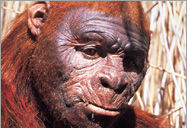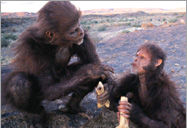By three million years ago, the world of Lucy and Australopithecus afarensis had vanished. Hidden forces were transforming the Earth's climate, with devastating consequences for the African landscape.Temperatures in Africa plummeted and the air became stripped of moisture. Humid woodland shrivelled away, leaving wide belts of open terrain in its place.
Spinning aroundThe cause of this environmental upheaval was to be found in space. The Earth orbits the Sun at a slight tilt, known as the axis of rotation. This means that as our planet spins, it points towards the Sun at some times and away from it at others. This is the origin of the seasons on Earth. Three million years ago, this axis was changing so that the Earth pointed away from the Sun for longer periods. This caused an overall cooling of the Earth, locking away moisture in ice at the North and South Poles. It also made the climate more seasonal.

Paranthropus boisei ate a tough-to-chew diet of vegetable foods.
In Africa, some animals that relied on the forests for their food died out. But others evolved to exploit other dietary sources. For example, many evolved physical adaptations to graze on the grass that colonised the deforested terrain.
Wildlife in Africa diversified as new animal species evolved to exploit different sources of food in a new mosaic of environments. The same seems to have happened to our ancestors, who had previously relied on forest foods such as soft fruit. After three million years, new ape-men were springing up all over the continent.
In East Africa, a hominid called
Paranthropus boisei became specialised so that it could eat tough-to-chew but more abundant plant foods such as nuts, roots and tubers (largely underground vegetables, the potato being a modern example).
Lantern jawsParanthropus boisei developed an enormous jaw with massive chewing muscles and huge back teeth to help him grind down these tough plant foods. By becoming a highly specialised vegetarian,
boisei ensured a comfortable life for itself.
The ratios of different types of carbon atoms, or isotopes, in fossils can tell us lots about what a fossil creature ate because different foods have different carbon isotope signatures. Dr Julia Lee-Thorp of the University of Cape Town in South Africa has found that isotopes in
boisei's southern African relative,
Paranthropus robustus, show that it ate a relatively high proportion of foods with a Carbon-4 (C4) signature.
C4 carbon usually comes from grass. Since the teeth of
robustus show it did not graze on grass, Lee-Thorp suggests it was consuming grass-eating insects, including termites. Archaeological finds show
robustus dug termites out of their mounds using sharpened animal bones. But other scientists suggest that
robustus could have obtained its high proportion of C4 carbon from the roots of plants like papyrus, which also have high C4 signatures.

Unlike boisei, Homo habilis ate almost anything that came their way.
Food was not as easily available for
Homo habilis, a hominid that lived alongside
boisei in East Africa. This ape-man could not eat the same tough plant foods that
boisei ate, because its jaw and teeth were too small.
Homo habilis had small teeth and ate anything it could lay its hands on, especially meat. But
habilis was no hunter. Attracted by circling vultures, it probably scavenged the leftovers from a big kill such as an antelope left in a tree by a leopard, or a large animal such as a wildebeest that had been slaughtered by lions.
Brain foodBecause meat is relatively easy to digest and rich in calories and nutrients, early
Homo lost the need for the big intestines of apes and earlier hominids. This freed up energy for use by other organs. This surplus of energy seems to have been diverted to one organ in particular - the brain. But scavenging meat from under the noses of big cats is a risky business, so good scavengers needed to be smart. At this stage in our evolution, a big brain was associated with greater intellect.
Big brains require lots of energy to operate: the human brain uses 20% of the body's total energy production. But the massive calorific hit provided by meat kick-started an increase in the brain size of early humans.Tooled upBut around two million years ago, telltale cut marks on the surface of animal bones reveal that early humans were using crude stone tools to smash open the bones and extract the marrow. Stone tools allowed early Homo to get at a food source that no other creature was able to obtain - bone marrow. Bone marrow contains long chain fatty acids that are vital for brain growth and development. This helped further fuel the increase in brain size, allowing our ancestors to make more complex tools.
The tools made by
habilis are called 'Oldowan tools'. The process used to make these tools was incredibly simple. Hominids picked up one stone, known as a core and broke it with another, known as a hammerstone or percussor. This gave them a sharp cutting edge that could pass through an animal's hide.
Chimp testYet even this crude form of tool-making required our ancestors to make a cognitive leap. When researchers at the Yerkes Primate Center in Atlanta showed an intelligent chimp called Kanzi how to strike a suitable flake from a stone core in order to cut a cord tied around a box containing food, Kanzi soon grasped the general idea. But after many months of trying, Kanzi had not managed to produce anything as deliberately crafted as an Oldowan flake.
Kanzi couldn't seem to comprehend that useful flakes are only produced if a hammerstone strikes the core at the right point, at the right angle and with the right force. By contrast, even the earliest Oldowan tool-makers understood this principle.
A victim of successParanthropus boisei would eventually pay for being a specialist in a changing world. Despite its successful way of exploiting the savannah, boisei became a footnote in human prehistory. They were driven to extinction, probably by an intense period of cooling and drying caused by the Ice Age. By remaining adaptable, early Homo ensured that when the world changed, they changed with it. But by two million years ago, a new species of Homo was evolving - one that would expand its horizons beyond the confines of Africa.
it also acknowledges rapid, catastrophic change, if only implicitly. Its central point seems to be that the genetic line that was more flexible and adaptable to the onset of the Ice Age survived, whereas others that were not died out. Homo Habilis might have had a hard time to survive compared to more specialized branches of the hominids for quite a while, but when rapid change came, it was able to adapt to it.